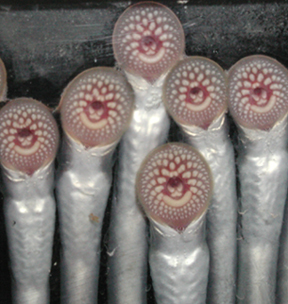|
Sea lamprey control in the Great Lakes and Lake Champlain is currently dependant on use of chemical lampricides to kill larval lamprey, and barriers to prevent spawning. We are investigating alternative methods for lamprey control that have lower ecological and economic impacts. Seasonal trapping of small streams by USFWS has already been effective in reducing or eliminating some stream populations of lamprey. Lamprey pheromones could be used to attract migratory adults and spawning lamprey into traps or away from biologically sensitive areas, reducing recruitment and therefore reducing the need for chemical control. We are also using microelemental analysis of lamprey otoliths (ear bones) to track the stream origins of parasitic lamprey, in order to focus control efforts on streams with the highest productivity of lamprey. Research on lamprey fecundity and factors that affect egg survival is being conducted to provide parameters for a life history model that will assist with optimization of control methods among streams in the Champlain basin.
Relevant Publications:
- Marsden, J. E., B. D. Chipman, L. J. Nashett, J. K. Anderson, W. Bouffard, L. E. D., J. E. Gersmehl, W. F. Schoch, N. R. Staats, A. Zerrenner. 2003. Evaluation of the eight-year sea lamprey control program on Lake Champlain. J. Great Lakes Res. 29 suppl. 1: 655-676.
- McLaughlin, R. L., J. E. Marsden, D. B. Hayes. 2003. Balancing the benefits of sea lamprey control with non-target effects: conceptual synthesis and policy development. J. Great Lakes Res. 29 suppl. 1:755-765.
- Zerrenner, A. and J. E. Marsden. 2005. Influence of larval sea lamprey density on transformer life history characteristics in Lewis Creek, Vermont. Trans. Am. Fish Soc. 134:687–696.
|




